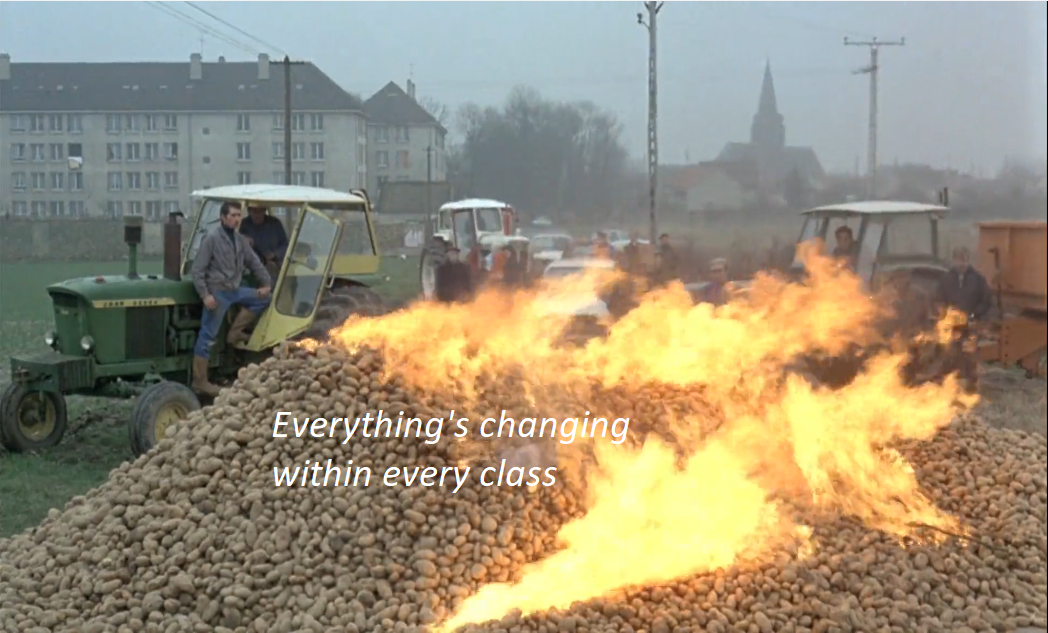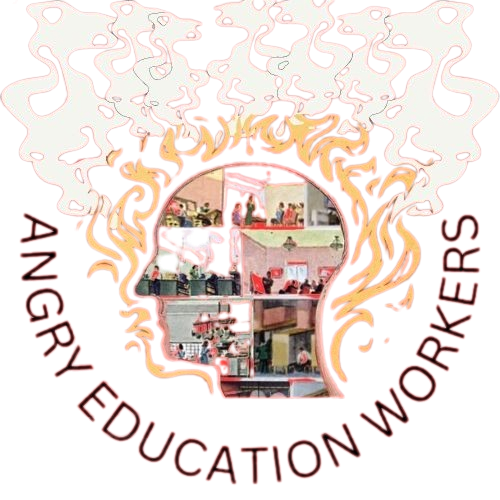Spontaneous Combustion: Reflections on an Unplanned Workplace Direct Action

A report and reflection about a series of direct actions and attempts to form a union by staff at a charter school from a former employee. We welcome other workplace reports, including anonymous ones.
Summer, 2022
The meeting went off the rails when I got a text from one of the Kindergarten teachers. The managers were lying to our faces. Everyone must have gotten the same messages, because my coworkers voices started to rise, their tone grew angry, and they stopped respecting management’s “meeting norms.”
Our in-person school year had ended a week before, but management insisted on a virtual “follow-up” meeting. So, everyone dutifully logged on at 10am. The regional director and her crony were waiting patiently. In an act worthy of Broadway, the regional director, with a too-bad-so-sad tone, announced that our principal and assistant principal had “left to pursue other opportunities. There was no one to replace them yet.
I work at a charter school. It is a Title I school where most students come from low-income or middle-income Black and Latin American families. Just a few months before I started working there, the board that owns the school switched charter management companies to a renowned national charter “turnaround” company: one of the more than 38 spawns of the notorious Mind Trust. Often credited as creating the blueprint for privatizing urban education.
Mismanagement, exploitation, and hypocrisy were in the company’s DNA. The company had grown like a cancer until it spread all the way to Detroit, New Orleans, Washington DC and other hotspots where the charter sub-sector is as big (or bigger) than the traditional public school district.
Staff, students, and families were already reeling from a traumatic year. So the announcement about the administration team blindsided us. While many of us did not like the principal and assistant principal—or, like myself, believe we could do without them altogether— we all agreed that they cared for the school community.
Meanwhile, the company had nearly run the school into the ground through mismanagement and financial profiteering schemes. They fired teachers while we were desperately understaffed, revoked already-earned bonuses for changing jobs, and did shady things to our SPED students to raise test scores. These were only the most glaring of a whole host of issues threatening to overwhelm and destroy the school.
So, we were all a little more than suspicious. The atmosphere was tense. A few staff members pressed the regional director for firm answers about our former leadership team—and received dodgy replies. One of the workers then asked: "were they let go, or did they choose to leave?" over and over again. Eventually, the regional director paused for a few seconds, then—finally—said "they chose to leave."
That's when I, and nearly everyone else, got the text message from the Kindergarten teacher. It was just an image thumbnail. Inside was the principal’s termination letter, sent by the director hosting the meeting.
It was too much. Under unbearable pressure, we exploded.
One of the special education teachers opened with a salvo about the terrible, contradictory communication and chaos. She ended with: “the 4:30 dismissal time has got to go.”
Our “offer letters” (we don’t have contracts) specified our roles and hours. We all got paid for eight hours a day while the company enforced nine hour days—and most teachers worked longer to barely keep up with the crushing workload. All year, the workers had expressed disgust with these polices. Several times, workers took direct action against them. Most of the time, teachers just refused to do the bullshit busy work admin gave out, and the company couldn’t do much about it because of the shortage of school workers.
Another worker demanded to know if support staff who'd been thrown into different roles, sometimes multiple times a day, would be paid for their extra work. The regional director kept sidestepping our questions. She said to get paid they needed to pull the records from the overflowing groupme, where people begged for classroom coverage all year. Several workers then pointed out that this group chat, owned by the former principal, was deleted. She had no answer for us, and we knew it. Even though we were on zoom, I could feel the rage bubbling up.
The school's social worker then cut the regional director off, “you all have come into a community dealing with immense trauma without thinking about what the community needs at all. Where is the support from this company? We only see y’all once a month!”
This had been something that agitated everyone on the shop floor all year: the company flew a couple of rich white people into the city from thousands of miles away for two days each month, then straight back home. She laid into them for five more minutes.
As she talked, and as several teachers came off mute to support her and launch into their own tirades, I realized this was an opportunity to unite the staff and build power. We'd built up a committee in the first few months of the 2021-2022 school year that took some direct actions. But without a proper formalized structure beyond a group chat, the committee only represented my immediate coworkers, and ultimately dissipated as understaffing at our school got worse and worse. It had felt like many workers at the school were content to take it on the chin and keep moving. That was incorrect. A deep rage extended across every grade band and role.
The task I’d struggled with was building a formal committee that met outside work hours. With the help of two external organizers from the IWW throughout the year, I accumulated the knowledge and skills I needed to do that. Here was an opportunity to apply that knowledge.
I noticed that the Kindergarten teacher had also sent out the image of the termination letter over email to many of us. Several people had already replied expressing outrage and feelings of betrayal.
I hopped into the thread and sent a message venting my own feelings and asking if anyone wanted to form a group chat to discuss how to make change in the workplace. Along with that, I whipped up a google form asking for contact info and platform preference—about ten people filled it out.
Workers are still on the meeting yelling at the regional director, by the way. The meeting was supposed to end by 11:00am. It was now 11:30. Our office assistant in charge of enrollment took the mic.
“The old logo is still on the building, the same color scheme from before, too. How is this company going to support rebranding?”
The director shifted a little bit, seemingly uncomfortable with giving us information about how the company works, “the operations team helps, but really it’s up to the school board.”
The worker shot back, “we need an action item here. You said operations, does that mean the school leadership, the board, or the company makes that decision? I’m leaving so someone else needs to connect those dots.”
She received vocal and written support from staff, and kept pressing her demand until management caved and agreed to weekly meetings with worker input.
Soon, staff members turned to berating management for abandoning us. No counselor, no substitutes, and a stream of overworked, underpaid staff members running for the door had taken their toll. Our social worker spoke out again, “we desperately need a counselor, why do we not have a counselor?”
“It all depends on enrollment, I’m sorry to say. That’s where the funding comes from, and with the school in a deficit, we can’t afford to backfill positions.”
One of the special education teachers—a 26 year teaching veteran not to be played around with—took her turn to criticize not just the company, but the invisible board who hired them.
“I see where they’re all coming from. We felt like the step child of the company, like we were never a part of it as a school community. And it feels like that with the board, too. I feel like they never see the work teachers are doing in the building. We need to let the community back into the building to see what’s going on. We need a commitment to a counselor.”
“It all depends on enrollment…”
Meanwhile, I was setting up our committee’s group chat and collaborating with coworkers to set up the infrastructure to keep ourselves together over the summer. I gathered non-work contacts.
The same special education teacher responded to the director’s vague answers: “We don’t know where any of this information comes from! Why is there no money? Are we non-profit or for-profit? I know y’all probably came into this city thinking this was a hot money making market for you with all the charter schools. But you don’t seem to realize that these other charter companies at least offer more resources."
I called the company out for doing nothing to cover the school’s deficit. Enrollment numbers had dropped over the pandemic, meaning less funding from the city government government while expenses rose. The regional director and I got into an exchange where she tried to evade my questions, and I kept bringing up my same points. She fell back to the same “it’s up to the board, government, and enrollment,” line, so I went back on mute to allow others to speak.
A teacher and a para-educator aired grievances about being thrown around into different positions with no warning. At that point, it was noon, and the regional director claimed she had another meeting she had to join. I wonder what she said about us afterwards.
Lessons Learned
There are a few lessons to be learned from this action and subsequent events.
1. Having a formal committee that’s representative of the workplace is essential.
2. Spontaneous direct actions by workers can win gains and catalyze a solid organizing committee.
3. However, without follow-up through one on one conversations and forming a solid collective culture, organizing committees can dissipate.
4. Without solid inoculation and leadership from an organizing committee, workers can lose heart and resort to more immediately confrontational, individualist direct actions that only invites retaliation with no benefit to collective worker power.
During the 2021-2022 school year, my coworkers and I were able to win certain concessions from management through loosely coordinated direct actions. For example, our ex-principal imposed an attendance policy that collectively punished the staff for the late arrivals of only a few (and those workers were only late consistently because of terrible conditions). Throughout the next day, groups of workers would go down to the office in waves to protest—spurred on by everyone else cheering them on.
We won.
Even so, most of the tangible organizing only happened in my department—the 3-5th grade instructional team—and the middle school instructional team. Within our own circles, we were strongly critical of the principal. Eventually, one of the 3rd grade teachers even lead us in writing up a formal complaint against them. But after consolidating a committee representing K-2, 3-5, para-educators, and food service staff, I discovered there was a significant minority of staff who loved our principal and assistant principal. The two of them being fired was what agitated them enough to take action and join the committee in the first place. Without a formal workplace-wide committee, we couldn’t see that. I had to readjust my perspective.
Our spontaneous actions made a difference. That year, we had an (official) eight hour workday, more robust curriculum support, and a seemingly much more competent leadership team. Less concretely, management treaded a lot more lightly around us, for a time.
The situation degraded rapidly. Exhausted from the previous school year, I had done little to cohere the organizing committee over the summer break. No one else had, either, but I don’t blame them. I was still the “main” worker-organizer, undermining our collective culture. We did meet a couple times during the “in-service” professional development weeks before the year started, but people started tuning out when the kids came into the building. That meant our committee became disconnected from the rest of the workers, especially those outside our own departments.
At that point, the new administration team showed their true faces. Workers got bullied and abused for the smallest mistakes in front of their classes by the principal. The assistant principals would barge into your classroom to observe and “evaluate” how you were teaching. If they didn’t like you, they would slap you with the lowest ratings they could get away with. Agitation went way up, but there seemed like no way to cohere it towards organized direct action that could build real union power in our workplace.
With the previous committee effectively disbanded, I tried to have one on one conversations with more openly militant coworkers to build a new one. But everyone I talked to was so burnt out that setting aside time and energy for an organizing campaign seemed impossible to them. We had become trapped within the confines of defensive, spontaneous collective actions by staff. That’s not to say these were totally ineffective. Staff struck down some horrendous policies and drove the abusive principal to resign two weeks into the school year. But the only person I could consistently count on to help get people organized was a single fellow teacher who I had become friends with. While the two of us were a pretty formidable team, we were no match for the retaliatory power of a multi-million dollar corporation spread across several states.
Obvious workplace leaders and agitators, the hammer came down on us. We were some of the primary targets of abuse from above. The two of us, along with a handful of other atomized workers, began to get hostile and defiant towards our bosses. Getting screamed at and written up were the usual consequences. Other folks were just fed up. They quit and went to different schools. Almost 20 by the end of the second month.
At the beginning of November, I followed them. My mental and physical health collapsed, so I quit, and went to work for a different school. The organizing campaign withered after that.
Our experience here is also instructive in the perils of organizing in so-called “hot shops” where agitation among the workers is at a fever pitch for long periods of time. In an individualist culture like the United States, people prefer to quit and seek a better job rather than stick around and organize where they are. All of this was magnified by the “Great Resignation,” which saw millions of workers quit and change jobs. Those who stick around are drowning, constantly, and can struggle to find the breathing room to organize.
Unionizing charter schools is a risky, dangerous struggle. Charters were created from the racist soil of "massive resistance" to desegregation specifically to destroy teachers' unions and privatize public education, as revealed by researcher Noliwe Rooks in her book Cutting School. From big companies and non-profits to small networks and single sites, charter schools are some of the nastiest union opponents there are. But it must be done. To defeat the education privatizers, we must defeat capitalism itself, charter school workers must stand shoulder to shoulder with organized workers in public schools. Only then can we raise the possibility of fusing our fractured education system into a truly public one. I hope this report can be of use to other workers struggling to build working-class power in the charter sub-sector of the education industry.

